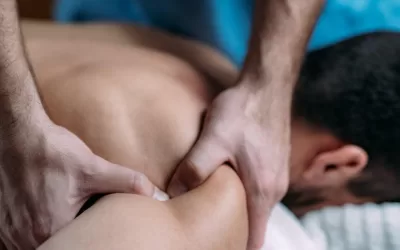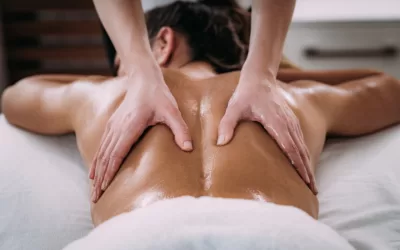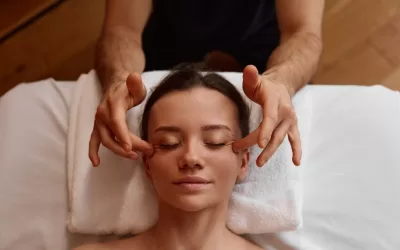Looking to take your swimming performance to the next level? Incorporating bodywork massage into your routine could be the game-changer you’ve been searching for. This valuable intervention has the potential to optimize your abilities in the water, enhancing both physical and mental aspects of your swimming.
Massage therapy offers a range of benefits that can directly impact your performance. By improving circulation, it helps deliver vital nutrients and oxygen to muscles, aiding in their recovery and reducing fatigue. Bodywork massage promotes flexibility, allowing for greater range of motion and improved technique in the water. Not only does it enhance physical capabilities, but it also addresses mental well-being by reducing stress levels and promoting relaxation.
We’ll delve into the specific areas it targets, the main benefits it provides, and how incorporating regular sessions into your training routine can lead to significant improvements. So buckle up and get ready to dive into this transformative journey!
Benefits of Bodywork Massage for Swimmers
Massage therapy is not just a luxury reserved for pampering oneself; it can also have significant benefits for swimmers. Whether you’re a professional athlete or someone who enjoys swimming as a hobby, incorporating bodywork massage into your routine can transform your swimming performance in several ways. Let’s explore the key benefits of bodywork massage for swimmers.
Improved Flexibility and Range of Motion
One of the primary advantages of bodywork massage for swimmers is its ability to improve flexibility and range of motion. Swimming requires a wide range of movements, and having optimal flexibility is crucial for efficient stroke mechanics. Regular massages help to release tension in the muscles and fascia, allowing them to stretch more easily. This increased flexibility enables swimmers to achieve longer strokes, better body rotation, and improved overall technique in the water.
Reduced Muscle Tension and Enhanced Relaxation
Swimming puts significant strain on various muscle groups throughout the body. Over time, this can lead to muscle stiffness and tension, hindering performance and increasing the risk of injury. Bodywork massage helps alleviate these issues by targeting specific areas of tension, releasing tight muscles, and promoting relaxation. The soothing touch of a skilled massage therapist stimulates the parasympathetic nervous system, triggering a state of deep relaxation that allows swimmers to recover faster from intense training sessions.
Enhanced Circulation and Nutrient Delivery
Efficient circulation plays a vital role in athletic performance by ensuring that oxygen-rich blood reaches the muscles efficiently. Bodywork massage helps enhance circulation by stimulating blood flow throughout the body. This increased circulation delivers essential nutrients such as oxygen and glucose to the muscles while removing metabolic waste products more effectively. As a result, swimmers experience improved endurance, reduced fatigue, and quicker recovery times between workouts or competitions.
Injury Prevention through Imbalance Identification
Swimming involves repetitive motions that can lead to imbalances in muscle strength and flexibility. These imbalances can increase the risk of overuse injuries, such as shoulder impingement or lower back pain. Bodywork massage can help prevent injuries by identifying and addressing these imbalances. A skilled massage therapist can assess your body’s alignment, muscle tension patterns, and movement restrictions to develop a targeted treatment plan that restores balance and reduces the likelihood of injury.
Different Types of Sports Massages for Swimmers
Deep Tissue Massage
Deep tissue massage is a type of sports massage that specifically targets the deep layers of muscle in the body. This technique uses firm pressure and slow strokes to release tension and promote healing. For swimmers, who often engage in intense physical activity, deep tissue massage can be highly beneficial. It helps relieve muscle soreness, improves flexibility, and enhances overall performance in the water.
Swedish Massage
Swedish massage is a popular form of bodywork that focuses on relaxation and promoting overall well-being. It utilizes long, flowing strokes that are designed to soothe the body and calm the mind. While it may not have the same level of intensity as deep tissue massage, Swedish massage can still provide numerous benefits for swimmers. By reducing stress and improving circulation, it helps swimmers recover faster from their training sessions and competitions.
Sports Massage
Sports massage is a specialized form of bodywork that caters specifically to athletes and individuals involved in sports activities. It targets specific areas of the body that are affected by repetitive motion or overuse injuries. For swimmers, sports massage can be particularly helpful in addressing common issues such as shoulder pain or tightness in the legs. By focusing on these problem areas, sports massage aids in relieving discomfort and enhancing range of motion.
Myofascial Release Technique
The myofascial release technique is another approach used in sports massages for swimmers. It aims to address restrictions within the connective tissues surrounding muscles known as fascia. By applying sustained pressure to these areas, myofascial release helps release tension and improve mobility. This technique can be especially beneficial for swimmers who experience tightness or restrictions due to repetitive movements involved in their sport.
It’s important to consider your specific needs and goals. Deep tissue massage is ideal for targeting deep muscle tension and promoting healing, while Swedish massage offers relaxation and overall well-being benefits. Sports massage focuses on addressing specific areas affected by repetitive motion, and myofascial release technique targets restrictions in the connective tissues.
Pre-event Sports Massage for Swimmers
Before diving into the pool for a swim meet or competition, swimmers can benefit greatly from a pre-event sports massage. This type of massage is specifically designed to warm up the muscles and prepare the body for optimal performance in the water.
Increase Blood Flow and Preparation
One of the key benefits of a pre-event sports massage is its ability to increase blood flow throughout the body. By applying targeted pressure and techniques, this massage helps stimulate circulation, delivering oxygen and nutrients to the muscles. This increased blood flow prepares the body for intense physical activity by loosening up tight muscles and enhancing flexibility.
Focus on Stimulating Muscles
Unlike other types of massages that may aim for relaxation or pain relief, pre-event sports massages focus on stimulating muscles without causing fatigue or soreness. The goal is to activate specific muscle groups that are crucial for swimming performance. By targeting these areas, such as the shoulders, arms, back, and legs, swimmers can enhance their speed, agility, and overall swimming technique.
Enhance Speed and Agility
By incorporating regular pre-event sports massages into their training regimen, swimmers can experience significant improvements in their speed and agility in the water. These massages help reduce muscle tension and promote better range of motion in joints. As a result, swimmers can achieve more powerful strokes while minimizing resistance in the water. The increased flexibility gained from these massages also aids in quick turns during races.
Reduce Muscle Soreness
Intense swim training loads can often lead to muscle soreness and fatigue. However, with regular pre-event sports massages, swimmers can effectively manage muscle soreness by promoting faster recovery times between training sessions. These massages help flush out metabolic waste products that accumulate during exercise while reducing inflammation in the muscles.
Prevent Muscle Cramps
Muscle cramps can be a common issue among competitive swimmers due to prolonged periods spent in the water. Pre-event sports massages can help prevent muscle cramps by increasing blood flow and oxygen supply to the muscles. These massages help release tension in the muscles, reducing the likelihood of cramping during a race.
Individualized Approach
It’s important to note that each swimmer may have different needs. Some swimmers may benefit from a more superficial massage, focusing on stimulating circulation and warming up the muscles gently. Others may require a deeper massage to target specific muscle groups or address areas of tightness or discomfort.
The Role of Massage in Swimming Recovery
Massage therapy plays a crucial role in enhancing the recovery process for swimmers. It offers numerous benefits that can transform your swimming performance by accelerating post-swim recovery, reducing muscle soreness and inflammation, flushing out metabolic waste products, and promoting relaxation.
The Role of Massage in Swimming Recovery
After an intense swim session or race, it’s common to experience muscle soreness and fatigue. This is where massage therapy comes into play. By targeting specific muscles and applying various techniques such as myofascial release, a skilled massage therapist can help alleviate muscle tension and promote faster recovery. Regular massages after swimming sessions can significantly reduce the time needed for your body to bounce back.
Reducing Muscle Soreness and Inflammation
Intense swimming workouts or races can lead to micro-tears in the muscles, resulting in soreness and inflammation. Massage therapy helps by increasing blood circulation to the affected areas, which aids in delivering essential nutrients while removing metabolic waste products. This improved circulation helps reduce inflammation, allowing your muscles to recover more efficiently.
Flushing Out Metabolic Waste Products
During intense physical activity like swimming, lactic acid and other metabolic waste products build up in the muscles. These waste products contribute to muscle soreness and fatigue. Massage therapy assists in flushing out these toxins from the muscles through increased blood flow and lymphatic drainage. By eliminating these waste products, massages support a quicker recovery process.
Promoting Relaxation for Better Recovery
Swimming requires both physical exertion and mental focus. The stress associated with training or competing can hinder your body’s ability to recover effectively. Regular massages help promote relaxation by reducing stress levels and releasing endorphins—the body’s natural feel-good hormones—resulting in a more relaxed state of mind during the recovery process.
Incorporating Regular Post-swim Massages
To fully reap the benefits of massage therapy for swimming recovery, it is important to incorporate regular massages into your routine. Consistency is key. By scheduling regular post-swim massages, you provide your body with the necessary care and support it needs to perform at its best.
Common Swim Injuries and How Massage Can Help
Swimming is a fantastic sport that offers numerous benefits for both the body and mind. However, like any physical activity, it can also lead to various injuries.
Swimmer’s Shoulder
One of the most prevalent injuries among swimmers is shoulder pain, commonly known as “swimmer’s shoulder.” This condition occurs due to overuse or improper technique, resulting in tension around the shoulder joint. The repetitive motion of swimming can cause strain on the muscles and tendons surrounding the shoulder.
Massage therapy plays a crucial role in relieving tension and reducing pain associated with a swimmer’s shoulder. Skilled massage therapists use techniques such as deep tissue massage and myofascial release to target specific areas of tightness or inflammation. By releasing tension and improving blood flow, massage helps promote healing and restore proper function to the affected shoulder.
Lower Back Pain
Lower back pain is another issue that many swimmers face due to muscle imbalances and tightness in the core area. The repetitive nature of swimming can lead to overuse of certain muscles while neglecting others, causing imbalances that put strain on the lower back.
Massage therapy can be highly effective in alleviating lower back pain by addressing these muscle imbalances. Through targeted techniques such as Swedish massage or trigger point therapy, a skilled therapist can release tension in overactive muscles while activating underused muscles. This rebalancing effect helps reduce strain on the lower back, leading to improved comfort and performance in the water.
Neck Strain
Swimming requires repetitive head movements as you breathe during each stroke. Over time, this constant rotation of the neck can result in strain and discomfort.
Massage techniques specifically designed for neck muscles can provide significant relief from this strain. Therapists may employ gentle stretching exercises along with deep tissue massage to release tension and increase flexibility in the neck area. By addressing the root cause of the strain, massage helps swimmers maintain proper alignment and range of motion in their necks, enhancing their overall swimming experience.
Knee Injuries
Knee injuries are not uncommon among swimmers, especially those who engage in intense training or competitive swimming. The knee joint is subjected to significant stress during kicking movements, making it susceptible to overuse injuries such as tendonitis or ligament strains.
Massage therapy can play a crucial role in preventing and treating knee injuries. Techniques like sports massage and myofascial release help improve blood flow to the knee joint, promoting healing and reducing inflammation. Regular massage sessions can enhance flexibility around the knee joint, reducing the risk of future injuries.
Dos and Don’Ts of Sports Massage for Swimmers
Communicate your specific needs and goals to the massage therapist
Communication is key. It’s important to let your massage therapist know about any specific needs or goals you have as a swimmer. Whether you’re looking to improve flexibility, relieve muscle tension, or enhance recovery, sharing this information will help the therapist tailor the massage to meet your individual requirements.
Drink Plenty of Water Before and After a Sports Massage Session
Hydration plays a crucial role in optimizing the benefits of a sports massage. Before your session, make sure to drink plenty of water to ensure that your muscles are well-hydrated. This will help facilitate the release of toxins and promote better circulation during the massage. Similarly, after the session, continue drinking water to flush out any metabolic waste that may have been released during the treatment.
Expect Long-Term Benefits From Regular Massages
While it’s natural to want immediate results from a sports massage, it’s important to understand that regular sessions yield long-term benefits. Consistency is key. By incorporating regular massages into your training routine, you can experience improved range of motion, reduced muscle soreness, enhanced recovery time, and overall better performance in the long run.
Avoid Scheduling Intense Workouts Immediately After Deep Tissue or Vigorous Sports Massages
Although sports massages can be invigorating and provide relief from muscle tension, it’s essential not to overexert yourself right after a deep tissue or vigorous session. These types of treatments can leave your muscles feeling relaxed but also potentially fatigued. To prevent injury and allow your body time to recover properly, avoid scheduling intense workouts immediately following these types of massages.
The Importance of Sports Massage After Swimming
After a grueling swim session, your body needs some TLC to recover and perform at its best. That’s where post-swim sports massages come into play. These massages are not just a luxury; they are an essential part of any serious swimmer’s training regimen. Let’s explore why sports massage is so important after swimming.
Preventing Delayed Onset Muscle Soreness (DOMS)
One of the key benefits of post-swim sports massages is their ability to prevent delayed onset muscle soreness, commonly known as DOMS. DOMS typically occurs 24 to 72 hours after intense exercise and can leave you feeling stiff and achy. By getting a massage right after your swim, you can minimize the severity and duration of DOMS.
Sports massages help increase blood flow to your muscles, which aids in the removal of waste products like lactic acid that contribute to muscle soreness. The targeted pressure applied during the massage also helps break down any knots or adhesions in your muscles, releasing tension and promoting better recovery.
Flushing Out Lactic Acid Buildup
Intense swim sessions can lead to a buildup of lactic acid in your muscles. This can cause fatigue and hinder your performance if not addressed promptly. Post-swim sports massages play a crucial role in flushing out this lactic acid buildup.
During the massage, the therapist uses various techniques like kneading and friction to stimulate blood circulation in your muscles. This increased blood flow helps carry away the excess lactic acid, allowing your muscles to recover faster and reducing stiffness or cramping.
Faster Recovery for Consistent Training
Consistency is key. Regular post-swim sports massages can significantly contribute to faster recovery times, enabling you to train more consistently without risking burnout or injury.
By increasing blood flow and oxygen delivery to your muscles, these massages help reduce inflammation and promote the repair of damaged tissues. This means you can bounce back quicker from intense swim sessions and be ready to hit the pool again sooner.
Reducing the Risk of Overuse Injuries
Swimming is a repetitive sport that places significant strain on certain muscle groups, such as the shoulders, back, and legs. Over time, this repetitive motion can lead to overuse injuries like tendonitis or muscle strains.
Post-swim sports massages can help prevent these injuries by addressing any imbalances or tightness in your muscles. The therapist will focus on specific areas prone to injury, using techniques like stretching and deep tissue massage to release tension and improve flexibility. This proactive approach reduces the risk of overuse injuries and keeps you in the water for longer.
Conclusion
Incorporating bodywork massage into your swimming routine is not just a luxury; it’s a strategic move to elevate your performance. From improving flexibility and range of motion to reducing muscle tension and enhancing circulation, the benefits are vast. The different types of sports massages cater to specific needs, ensuring a tailored approach for swimmers.
Pre-event sports massages prepare your muscles for optimal performance, increasing blood flow, stimulating key muscle groups, and enhancing speed and agility. On the other hand, post-swim sports massages play a crucial role in preventing muscle soreness, flushing out lactic acid, and promoting faster recovery, allowing you to maintain consistent and effective training.
Remember the dos and don’ts—communicate with your massage therapist, stay hydrated, expect long-term benefits from regular sessions, and avoid intense workouts immediately after vigorous massages.
So, dive into the world of bodywork massage, and let it be the game-changer that propels you to new heights in the water!
Transform Your Swim Performance: Experience the Healing Touch of Bodywork Massage
Are you a swimmer or athlete constantly battling pain and unsure where to find relief? Look no further, as Beyond Ergonomics offers the perfect solution tailored just for you. Understanding that body imbalances, repetitive motions, and inadequate movement often lead to injuries and chronic pain, we specialize in identifying these issues and fostering positive change. Our unique approach is specifically designed to address the challenges faced by athletes and desk professionals alike.
At MedicinEvolution, we go beyond the conventional to offer Bodywork Massage for Swimmers – a specialized service aimed at reducing your pain and improving your overall well-being. This isn’t just a massage; it’s a journey towards discovering and rectifying the imbalances that hinder your performance and comfort. Whether you’ve struggled with persistent pain or are looking to enhance your swimming performance, MedicinEvolution Bodywork Beyond Massage is your gateway to a healthier, more balanced body.
Don’t let pain hold you back any longer. Embark on a transformative journey with us and feel the difference as we help you swim towards a pain-free life. Schedule your appointment with MedicinEvolution today and dive into the world of enhanced performance and comfort. Your body deserves the best, and we are here to provide it.





